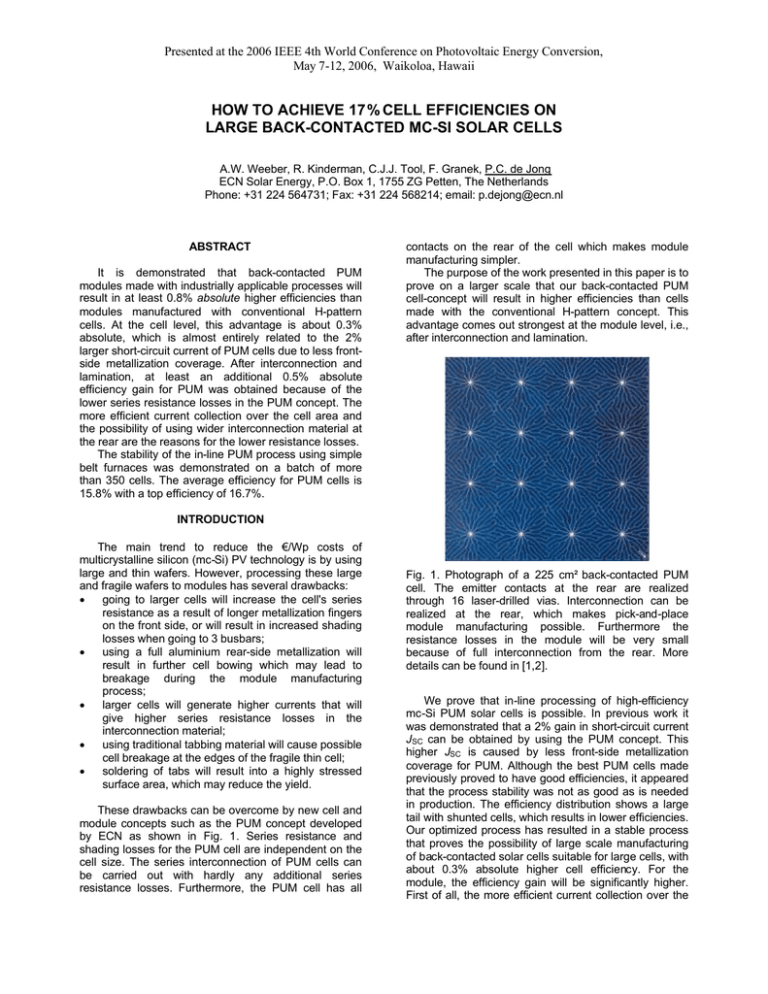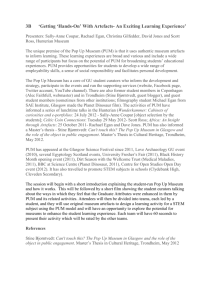PUM 17
advertisement

Presented at the 2006 IEEE 4th World Conference on Photovoltaic Energy Conversion, May 7-12, 2006, Waikoloa, Hawaii HOW TO ACHIEVE 17% CELL EFFICIENCIES ON LARGE BACK-CONTACTED MC-SI SOLAR CELLS A.W. Weeber, R. Kinderman, C.J.J. Tool, F. Granek, P.C. de Jong ECN Solar Energy, P.O. Box 1, 1755 ZG Petten, The Netherlands Phone: +31 224 564731; Fax: +31 224 568214; email: p.dejong@ecn.nl ABSTRACT It is demonstrated that back-contacted PUM modules made with industrially applicable processes will result in at least 0.8% absolute higher efficiencies than modules manufactured with conventional H-pattern cells. At the cell level, this advantage is about 0.3% absolute, which is almost entirely related to the 2% larger short-circuit current of PUM cells due to less frontside metallization coverage. After interconnection and lamination, at least an additional 0.5% absolute efficiency gain for PUM was obtained because of the lower series resistance losses in the PUM concept. The more efficient current collection over the cell area and the possibility of using wider interconnection material at the rear are the reasons for the lower resistance losses. The stability of the in-line PUM process using simple belt furnaces was demonstrated on a batch of more than 350 cells. The average efficiency for PUM cells is 15.8% with a top efficiency of 16.7%. contacts on the rear of the cell which makes module manufacturing simpler. The purpose of the work presented in this paper is to prove on a larger scale that our back-contacted PUM cell-concept will result in higher efficiencies than cells made with the conventional H-pattern concept. This advantage comes out strongest at the module level, i.e., after interconnection and lamination. INTRODUCTION The main trend to reduce the €/Wp costs of multicrystalline silicon (mc-Si) PV technology is by using large and thin wafers. However, processing these large and fragile wafers to modules has several drawbacks: · going to larger cells will increase the cell's series resistance as a result of longer metallization fingers on the front side, or will result in increased shading losses when going to 3 busbars; · using a full aluminium rear-side metallization will result in further cell bowing which may lead to breakage during the module manufacturing process; · larger cells will generate higher currents that will give higher series resistance losses in the interconnection material; · using traditional tabbing material will cause possible cell breakage at the edges of the fragile thin cell; · soldering of tabs will result into a highly stressed surface area, which may reduce the yield. These drawbacks can be overcome by new cell and module concepts such as the PUM concept developed by ECN as shown in Fig. 1. Series resistance and shading losses for the PUM cell are independent on the cell size. The series interconnection of PUM cells can be carried out with hardly any additional series resistance losses. Furthermore, the PUM cell has all Fig. 1. Photograph of a 225 cm² back-contacted PUM cell. The emitter contacts at the rear are realized through 16 laser-drilled vias. Interconnection can be realized at the rear, which makes pick-and-place module manufacturing possible. Furthermore the resistance losses in the module will be very small because of full interconnection from the rear. More details can be found in [1,2]. We prove that in-line processing of high-efficiency mc-Si PUM solar cells is possible. In previous work it was demonstrated that a 2% gain in short-circuit current JSC can be obtained by using the PUM concept. This higher JSC is caused by less front-side metallization coverage for PUM. Although the best PUM cells made previously proved to have good efficiencies, it appeared that the process stability was not as good as is needed in production. The efficiency distribution shows a large tail with shunted cells, which results in lower efficiencies. Our optimized process has resulted in a stable process that proves the possibility of large scale manufacturing of back-contacted solar cells suitable for large cells, with about 0.3% absolute higher cell efficiency. For the module, the efficiency gain will be significantly higher. First of all, the more efficient current collection over the Presented at the 2006 IEEE 4th World Conference on Photovoltaic Energy Conversion, May 7-12, 2006, Waikoloa, Hawaii cell area and the possibility of using interconnection material that can be much wider than the conventional 2 mm tabs cause PUM modules to result in much lower series-resistance losses than conventional modules. In addition, the PUM cells will be packed more densely in the module because no tabs are needed in between the cells and because the area for the string matrix is no longer needed. efficiencies can be seen in the first three rows of Table 2. It appears to be possible to gain nearly a full percent in absolute efficiency by altering the measurement configuration. We measured the H-pattern cells with a dual-probe onto each busbar, with a dual-probe configuration onto pre-tabbed busbars using 200µm tab material and with a multi-probe onto the busbar (8 current probes per busbar). The PUM cells were measured using an application-specific measurement chuck (Fig. 2) with 16 current probes for the emitter contacts at the rear and 15 for the base terminals. EXPERIMENTAL PUM VERSUS H-PATTERN CELLS In order to prove the benefits for PUM cells and modules a direct comparison was made on 225 cm² 240µm mc-Si wafers from a single commercial supplier. The processing was carried out on groups of neighboring wafers. One group was processed into conventional H-pattern cells while the other group was processed into PUM cells, respectively. The process carried out was the ECN baseline process. This is a simple industrial processing sequence resulting in an average efficiency of 16% for commercial 156 cm2 mcSi wafers, and is similar to the process described in [3]. The process steps are described in Table 1. Table 1: Simple in-line solar cell processing on 225 cm² mc-Si wafers 1. Laser drilling of 16 holes (PUM cells only) 2. Acidic etching for saw damage removal and surface texturing 3. Homogeneous 60-65 W/sq baseline emitter, i.e., double-sided spin-on phosphorous source and infrared-heated metal-belt furnace emitter diffusion 4. SiNx:H deposition with MicroWave Remote PECVD system 5. Screen-printing of the Ag front side, Ag rear side and Al rear side metallization 6. Simultaneous firing of the front and rear side metallization and Al Back Surface Field (BSF) formation using an infrared heated belt furnace. 7. Emitter edge isolation 8. Rear-side emitter isolation (PUM cells only) Fig. 2. Photograph of the PUM measurement chuck. Current probes (16 to the emitter terminals and 15 to base terminals) contact the cell from the rear. Therefore, the only realistic comparison between Hpattern cells and PUM cells must be made after the interconnection has established. Because of this, all cells were interconnected according to industrially bestapplied methods. This implies that H-pattern cells were interconnected with relatively thick 200µm x 2mm solder-plated copper tabs (57mW /m). The PUM cells were interconnected with a 45µm x 20mm wide foil (29mW /m). The H-pattern and PUM cell parameters were determined by inter-connecting the probe terminals at the tab/foil matrix extension using the fourwire measurement technique. Finally, all cells were laminated onto 20 x 20 cm² white tedlar back-sheet foils. Hence, the measured characteristics are the encapsulated cell efficiencies including the benefit of an enlarged white area. The measurement results clearly prove that PUM has advantages over its H-pattern counterpart. PUM laminates perform 6% relative, (0.8% absolute), better than H-pattern cell laminates. This is mainly caused by a 2% larger short-circuit current due to less shading losses, and an additional 3% gain because of the lower resistive losses. If industrial standard 125µm or 150µm tabs were used, this effect would even have been larger. Nevertheless, this experiment clearly proves that fill-factor differences between PUM cells and H-pattern cells become larger after interconnection. The somewhat higher VOC value of the PUM cells accounts for an additional 1% gain in efficiency, but its origin is The processed cells, both H-pattern and PUM, have been further processed into single-cell laminates. The current-voltage (IV) measurements before tabbing, after tabbing and after lamination were carried out using the class A solar simulator at ECN. The measurements were performed according to the ASTM-E948 standard [4]. The measurement results have been corrected for spectral mismatch. RESULTS AND DISCUSSION PUM VERSUS H-PATTERN CELLS The average values of the IV characteristics are presented in Table 2. A direct comparison between Hpattern cells and PUM cells is not very realistic by the different nature of the measurement methods. For Hpattern cells it is to be expected that IV measurement results depend on the probe configuration. The impact of this configuration on the measured fill factors and 2 Presented at the 2006 IEEE 4th World Conference on Photovoltaic Energy Conversion, May 7-12, 2006, Waikoloa, Hawaii not fully understood. contacting and formation of the Back-Surface Field (BSF). All contacts were fired simultaneously using an infrared lamp-heated belt furnace. Junction isolation was carried out with a 1064nm Nd:YAG laser, i.e., the same laser as was used for making the vias. The integral process was optimized to obtain high efficiencies on a large amount of solar cells, thus with a good process stability. Identifying the shunt paths and adjusting the process to prevent shunting have been key research issues [8]. Table 2: IV characteristics averaged over the groups of neighboring wafers. JSC VOC (mA/cm²) (mV) 34.2 607 FF (%) 71.8 h (%) 14.9 H-pattern dual-probe H-pattern dual-probe on tab 34.2 608 75.5 15.7 H-pattern multi-probe 34.2 607 75.4 15.7 PUM multi-probe 34.9 612 74.8 16.0 H-pattern tab 57mW/m 34.2 608 72.0 15.0 PUM foil 29mW/m 35.0 612 74.0 15.9 H-pattern laminated 35.0 609 72.4 15.4 PUM laminated 35.8 613 73.9 16.2 RESULTS AND DISCUSSION HIGH-EFFICIENCY PUM CELLS From detailed analysis of the possible shunt paths in the PUM cell it was found that shunt paths around the hole were most critical [8]. By optimizing the emitter laser isolation and the corresponding emitter processing we improved shunt resistances on 225 cm2 cells from about 7 W to beyond 50 W. With this improved process an efficiency of 16.7% was reached for a 225 cm2 large mc-Si PUM cell. The data for the cell parameters can be found in Table 3. A remarkable result is that the encapsulated PUM cell efficiency is about 0.2% absolute higher than the PUM multi-probe measurement. This implies that the current gain due to improved light coupling overcompensates the fill-factor losses due to interconnection. It should be noted that light-coupling effects, the enlarged white area, and mismatch factors may cause some exaggeration of the measured values. The relative values, however, can be compared and show a clear efficiency gain of 0.8% absolute for PUM after lamination. As described before the process applied typically yields an average efficiency of 16.0% on 125mm Hpattern cells [3]. Apart from wafer quality, there are two additional effects that explain why the H-pattern cells in this experiment stay somewhat behind. Firstly, the up scaling from 125mm to 150mm wafers causes additional resistive losses. Secondly, the processing was truly industrial which implies that 6mm wide Ag busbars were printed on the rear of the H-pattern cells. This leads to some loss of the BSF effect in the busbar regions. Table 3: Results of a high-efficiency experiment on a total of 354 PUM cells of 225 cm². The PUM cells were measured with the specific PUM chuck as shown in Fig. 2; so not interconnected. JSC (mA/cm²) 34.6 34.6 35.6 Average Median Champion cell VOC (mV) 615 615 618 FF (%) 74.3 74.6 75.9 h (%) 15.8 15.9 16.7 16% PUM cells 2003 14% PUM cells 2004 proportion (bin size 0.1%) PUM cells 2005 EXPERIMENTAL HIGH-EFFICIENCY PUM CELLS High efficiency PUM cells were made using 225 cm2 multicrystalline silicon (mc-Si) wafers with a thickness of 270 µm. The processing used is similar to ECN's in-line baseline based on firing-through SiNx:H and screenprinting. The processing differs from our baseline process by its advanced emitter and several changes of the metallization and firing conditions [5,6,7]. A doublesided emitter was used. On the front side, an advanced high-ohmic homogeneous emitter with a sheet resistivity of about 75 W/sq was made. A low-ohmic emitter on the rear with a sheet resistivity of about 55 W/sq was made simultaneously to minimize shunting and to maximize gettering of impurities. Passivating SiNx:H layers were deposited with an in-line Microwave Remote PECVD system. Cells were metallized using advanced screenprinting. Silver contacts were printed at the front and on the rear. Aluminium was printed on the rear for 12% 10% 8% 6% 4% 2% 0% 12 12.5 13 13.5 14 14.5 15 15.5 16 16.5 17 efficiency (%) Fig. 3. Evolution of PUM cell efficiencies since 2003. The distribution of efficiencies of a complete batch of 354 cells can be seen in Fig. 3. The distributions of previous experiments carried out in 2003 and 2004 are shown as well. From this figure it can be seen that the average efficiency since 2003 is increased with more than 2% absolute, and since 2004 with about 0.6% absolute. Application of the advanced-emitter process to PUM appears not to be straightforward. In particular the silver paste that fires through the rear-side emitter may cause severe shunting because of the absence of the SiNx:H 3 Presented at the 2006 IEEE 4th World Conference on Photovoltaic Energy Conversion, May 7-12, 2006, Waikoloa, Hawaii layer. Therefore, the choice of the rear-side silver paste and the required temperature settings had to be compromised in a way that we could not fully benefit from the high-efficiency potential of the advanced emitter. In addition, we had our doubts about the material quality. Therefore, a few 225 cm2 H-pattern reference cells processed with our standard baseline emitter were used to obtain neighbouring information regarding the wafer quality. The cell results are shown in Table 4. The multi-probe configuration was used for the H-pattern cells and the specific PUM chuck of Fig. 2 for measuring the PUM cells. ACKNOWLEDGMENTS Mario Kloos and Peter Buur of ECN are obliged for their technical support for manufacturing the modules. We gratefully acknowledge the financial support from the Dutch Economy, Ecology and Technology (E.E.T.) program. E.E.T. is an initiative of the Ministry of Economic Affairs, the Ministry of Education, Culture and Science and the Ministry of Public Housing, Physical Planning and Environment. REFERENCES Table 4: IV characteristics averaged over the groups of neighboring wafers. H-pattern stand. emitter JSC (mA/cm²) 33.4 VOC (mV) 604 FF (%) 74.4 h (%) 15.0 PUM advanced emitter 34.9 615 74.1 15.9 [1] J.H. Bultman et al., “Fast and easy single step module assembly for back-contacted c-Si solar cells with conductive adhesives” , 3rd WCPVSEC, Osaka, 2003. [2] P.C. de Jong et al., “ Single-step laminated full-size PV modules made with back-contacted MC-Si cells and conductive adhesives”, 19th EPVSEC, Paris, 2004. It appeared that the material quality was relatively poor because the H-pattern cells performed 4% relative worse than in the earlier described PUM versus Hpattern experiment. Comparison of the H-pattern multiprobe cell results of Table 2 with Table 4 shows that all cell parameters (VOC, FF and especially JSC) stay behind, leading to an average H-pattern cell efficiency of 15.0% only. This means that using the better material quality will increase the efficiency of the PUM cells with about 4% relative and the champion cell will exceed 17% easily. [3] A. Weeber et al., “16% mc-Si cell efficiencies using industrial in-line processing”, 19th EPVSEC, Paris, 2004. [4] www.astm.com [5] C.J.J. Tool et al., “Straightforward in-line processing for a 16.8% efficient mc-Si solar cell”, IEEE PVSC, Orlando, 2005 [6] A.Weeber et al., “17% mc-Si solar cell efficiency using completely in-line processing with improved texturing and screen-printed contacts on lowly doped emitters, 20th EPVSEC, Barcelona, 2005 CONCLUSIONS The processing of PUM cells was improved considerably over the last years. This has resulted in an efficiency increase of more than 2% absolute since 2003. The average efficiency of more than 350 PUM cells, with a size of 225 cm², is 15.8% with a top efficiency of 16.7%. These efficiencies were achieved after processing relatively poor-quality wafers into PUM cells. Efficiencies beyond 17% should be possible with better material quality and optimized processing. The comparison between H-pattern cells with PUM cells is to be treated with delicacy. The only reliable comparison can be achieved after interconnection and/or lamination of the solar cells. It was shown that PUM cells achieve a short-circuit current gain of 2% in comparison to their H-pattern counterparts due to less shading losses. After interconnection, an additional gain of at least 3% is achieved as a result of the lower resistance losses and the more efficient current collection over the cell area. It is shown that after interconnection and lamination PUM results in 0.8% higher absolute efficiency than conventional H-pattern modules. This proves that PUM module efficiencies beyond 16% are possible with PUM cells that are processed using a simple industrial applicable in-line process sequence. [7] C.J.J. Tool et all., “17% mc-Si solar cell efficiency using full in-line processing”, 15th IPSEC, Shanghai, 2005 [8] F. Granek et al., “A Systematic approach to reduce process-induced shunts in back-contacted mc-Si solar cells”, Submitted to this conference 4



